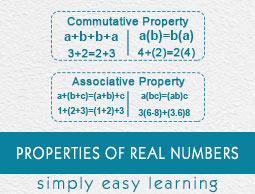
- Properties of Real Numbers
- Home
- Identifying Like Terms
- Combining like terms: Whole number coefficients
- Introduction to properties of addition
- Multiplying a constant and a linear monomial
- Distributive property: Whole Number coefficients
- Factoring a linear binomial
- Identifying parts in an algebraic expression
- Identifying equivalent algebraic expressions
- Introduction to properties of multiplication
Introduction to properties of addition
Introduction
In this lesson, we learn few properties of addition, like the identity property, the commutative property and the associative property.
Identity property
Identity property of addition states that the sum of any number and 0 is the same number.
For any number a,
a + 0 = a
0 + a = a
For example −
11 + 0 = 11; 0 + 11 = 11
Commutative property of addition
In an addition, the terms that are added are called the addends and the result of the addition operation is called the sum.
The commutative property of addition states that changing the order of the addend in an addition operation does not change the sum.
For any two numbers a and b,
a + b = b + a
Associative property of addition
The associative property of addition states that the sum of numbers remains same regardless of how you group the numbers.
For any three numbers a, b and c,
(a + b) + c = a + (b + c)
Example 1
Fill in the blank and identify the property of addition in the following equation.
0 + _ = 21
Solution
Step 1:
Identity property of addition states that the sum of any number and 0 is the same number.
Step 2:
So, 0 + 21 = 21
Step 3:
So, the answer is 21
Example 2
Fill in the blank and identify the property of addition in the following equation.
10 + 16 = 16 + _
Solution
Step 1:
The commutative property of addition states that changing the order of numbers in an addition operation does not change the sum.
a + b = b + a, where a, b are any numbers.
Step 2:
So, 10 + 16 = 16 + 10
Step 3:
So, the answer is 10
Example 3
Fill in the blank and identify the property of addition in the following equation.
(2 + _) + 13 = 2 + (8 + 13)
Solution
Step 1:
The associative property of addition states that the sum of numbers remains same regardless of how you group the numbers or where you put the parentheses in the addition.
(a + b) + c = a + (b + c), where a, b and c are any real numbers
Step 2:
So, (2 + 8) + 13 = 2 + (8 + 13)
Step 3:
So, the answer is 8